Analysis of Structural Characteristics of Dispersive Breathable Bricks
Due to the special structure of the dispersion block, the dispersion-type air-permeable brick avoids the problem of the slit steel of the slit-type air-permeable brick, and can ensure good air permeability; the air bubbles are small and uniform, and the bottom blowing and mixing effect is good. It is because of these The function of the dispersion type ventilation brick has been widely used. Today, the editor will give you a specific introduction to the function of the new type of dispersion type ventilation brick for the pure ladle.
1, Internal structure
The diffused ventilation brick needs to make the bottom round table and the dispersion block first, and then form the brick core like ordinary slit ventilation bricks, and the production process is more complicated.
2, Physical and chemical indicators
In order to ensure the long life of the dispersive block, the high-specification synthetic raw materials with high strength, high refractoriness and excellent corrosion resistance are selected, and the combined structure of the breathable inner core and the dense high-strength material is adopted.
1, Microstructure
newDispersion type breathable brickBecause of its microstructural characteristics, there will be no impermeability or poor bottom blowing of the slit sandwiched steel structure that the original slit-type ventilation bricks often present. With a large temperature gradient, part of the thermal stress generated will converge near the slit, especially the thermal stress at the outlet of the slit is larger, which will change the standard of the slit during use, resulting in the molten steel simply intruding into the slit to form a bottom blowing failure. In addition, if the bottom blowing valve is quickly closed at the end of the purification process, the molten steel will enter the slit with positive pressure, so it is necessary to install a reverse osmosis check valve on the argon blowing pipeline. Therefore, the slit type breathable brick must be suitable and stable The standard slit airway standard and the raw material with better thermal stability can reduce the slit steel. The ventilation channel of the dispersive breathable brick is a large number of connected pores dispersed inside the brick body. These micron-scale curved channels constitute the penetration of molten steel. The larger resistance of the steel is basically non-penetrating in actual use. The air bubbles generated by the dispersive breathable brick are small, uniform and full, and it is easier to stir the molten steel to a uniform temperature, and it is easier to promote the floating of inclusions to achieve better quality. effect.
4, thermal stability
The new diffused type permeable brick is not easy to cause cross-section of the brick core surface. When blowing argon, the ordinary slit type permeable brick is in direct contact with the high-temperature molten steel at the outlet of the slit, and the cold air flow continuously flows out, resulting in a large temperature gradient, forming a slit The thermal stress at the air outlet is particularly large, coupled with the rapid cooling and rapid heating effect during use, it is easy to cross the air outlet near the slit, causing the slit to shift and the bottom to blow through. The thermal stress of the dispersive permeable brick is easy to form the cross-section of the slit-type breathable brick, which puts forward relatively high requirements for the thermal shock resistance of the refractory material. However, there are micron-scale gas channels on the entire working surface of the dispersive breathable brick. The temperature gradient is small, so the new diffused and breathable brick is not easy to cause cross-section of the brick core surface.

Previous: The intermediate frequency furnace charge knotting process needs to pay attention to details sharing
Related Industry Knowledge
- Features and Benefits of Coil Clay
- What are the advantages of a good furnace lining
- Misunderstandings in the use of ramming materials in intermediate frequency furnaces
- Phenomenon analysis of failure of argon blowing of ladle permeable bricks and how to improve the rate of argon blowing
- Where is the consumption reduction and energy saving of breathable bricks reflected?
- How to improve the service life of intermediate frequency furnace lining
- Reasons for damage to intermediate frequency furnace lining and how to solve them
- The performance and advantages of breathable brick
- The intermediate frequency furnace charge knotting process needs to pay attention to details sharing
- Introduction of construction method of ramming material in intermediate frequency furnace
- Composition and performance of ramming material for glass kiln
- Furnace lining manufacturers tell you how to improve the smelting speed of the intermediate frequency furnace
- Introduction to the difference between ramming material and castable material
- Do you know how the breathable brick is damaged?
- How to choose zirconium ramming material for glass kiln bottom
- Matters needing attention in the knotting process of wear-resistant ramming material
- How to use electric furnace lining to repair electric furnace
- Ramming material manufacturers tell you the influence of sliding nozzle refractories on breakout


